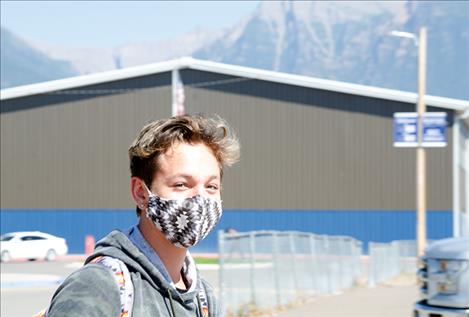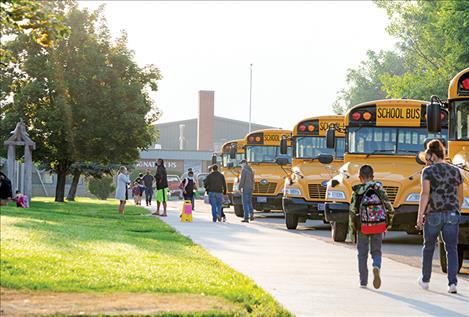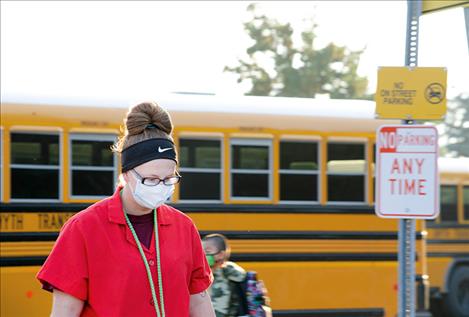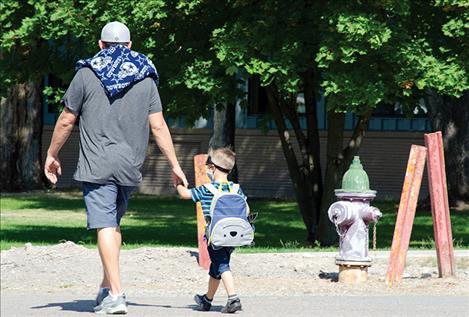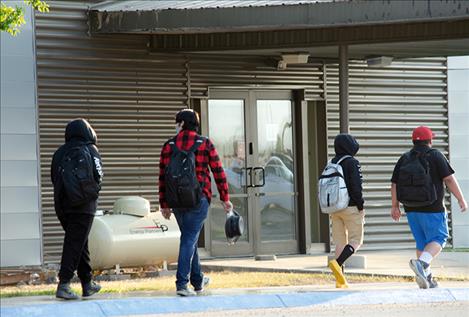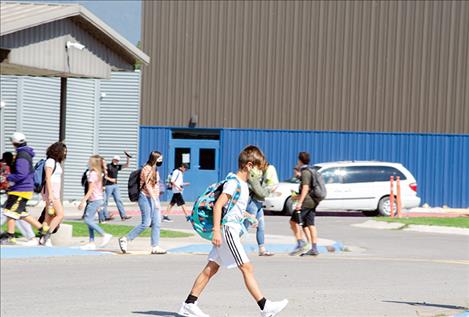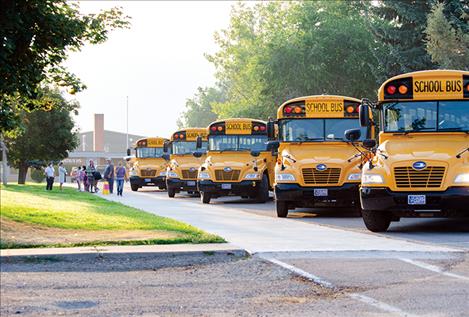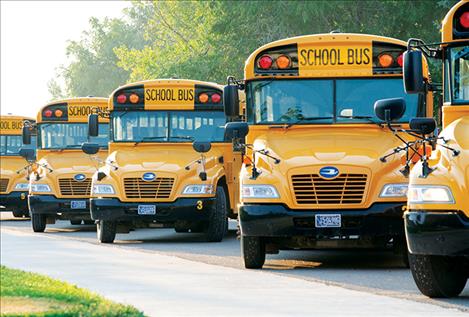On-campus instruction resumes during historic pandemic
Hey savvy news reader! Thanks for choosing local.
You are now reading
1 of 3 free articles.
ST. IGNATIUS – Students across Lake County put on their masks and went back to school last week during uncertain times.
At the St. Ignatius High School, student Kayden Carter, 16, said the mask got a bit warm during the school day, but he didn’t mind wearing it. He said it was much better than going to school online because, mostly, he missed his friends.
“In-person (learning) is also much easier than online because you have a teacher there to help you with the work and motivate you,” he said.
The high school junior thought for a moment and said wearing a mask was also worth a little discomfort to prevent the spread of COVID-19.
“I’ve been going to school here since kindergarten, and I’ve never experienced anything as weird as this pandemic,” he said.
Montana children haven’t attended in-person public school since the doors were closed on March 16. Governor Steve Bullock directed K-12 schools to close in an effort to slow the COVID-19 virus and protect vulnerable residents.
Schools were initially going to be closed for a few weeks, but after March 27, it was apparent that the virus was worse than expected, so the schools remained closed for the school year; during that time, teachers directed students to log in to online learning programs where they continued to teach children virtually.
Switching to online school required a lot of adjustment and technical development. Schools quickly surveyed their populations to determine who had internet and who needed support. Computers were loaned to students who needed them and internet hotspots were developed. At the time, teacher Valerie Umphrey said the change was stressful for students, parents and teachers. “For some, this is a very stressful time. It’s a change in routine. We are dealing with things we haven’t had to do before. It takes some adjusting and communication.”
The adjustments were made and children did complete the school year. The seniors in Lake County graduated in socially distanced ceremonies that were outside for the first time. Schools in the county worked to make graduation ceremonies special by doing things like displaying banners with graduate photos and holding parades after the ceremony so the public could congratulate graduates from a distance.
During the summer months, administrators and teachers worked to develop a plan to bring children back to in-person school. Lake County Superintendent of Schools Carolyn Hall said, during the summer, that guidelines from the Centers for Disease Control, the Montana Office of Public Instruction, the Montana School Board Association and Lake County Public Health were utilized to develop the plan. She said families also said they wanted schools to be open.
St. Ignatius School District Superintendent Jason Sargent said the first week back to school went well. Students could choose to continue online learning and about 15 percent took the option in the high school and middle school. The number was higher for the elementary school, which was about 50 percent.
For those at school, the biggest problem occurred during lunchtime in the middle school when it became evident that the students weren’t going to be able to spread out to eat their meal. The problem was easily fixed: “We decided to separate them into two groups with two classes in the lunchroom and one group staying in a classroom,” he said. The students in the elementary school stayed in their classrooms for the noon meal. High school students were able to go outside for lunch and also spread out in other places.
“After three days of school, I think we had it figured out,” Sargent said.
Besides physically distancing, other safety precautions include temperature sensors. The school is in the process of finishing the installation on a temperature-gauging system that was scheduled to be finished on Monday, Aug. 31.
“There was a rumor that the system was broken, but really, we were waiting for a power source so we could finish hooking it up,” he said. “It’s like an airport thermal sensor. When people come through the doors, it takes a temperature. If anyone is over 100.4, the system takes their picture and alerts administrators so the student can be isolated.”
The temperature-sensing system is set up around the school with five cameras, located at the entrance and in the hall, and it takes the temperature of students and staff all day long. The CDC has reported that a fever is one of the main symptoms of the virus, along with chills, a cough, shortness of breath, fatigue, muscle aches, headache, loss of taste or smell, sore throat, congestion or runny nose, nausea or vomiting and possibly diarrhea.
The CDC states: “Some studies have tried to identify which symptoms may best predict whether an individual has COVID-19, although these studies have primarily focused on those over 18-years-old. In children, fever has been the most frequently reported symptom. Additionally, there is no symptom or set of symptoms that only occurs in children diagnosed with COVID-19.”
As far as masks, the CDC said the latest science affirms that cloth face coverings are a “critical tool” in the fight against COVID-19. The CDC continued to state that masks are particularly effective when used universally within a community.
“We are not defenseless against COVID-19,” said CDC director Dr. Robert R. Redfield. “Cloth face coverings are one of the most powerful weapons we have to slow and stop the spread of the virus.”
Sargent said the students adjusted to wearing a mask during the school day. “The kids don’t seem too affected by wearing them,” he said. “We also have plastic shields on the desks, and we ordered masks with our bulldog mascot on them for students and staff.”
Adjusting to the pandemic has had a few advantages in communication for the school like the virtual meeting program that made it easier for families, teachers and administrators to collaborate. The school also advanced technology programs for teachers and students to communicate virtually and allow students to see a week’s lessons.
No one knows for sure how this school year will turn out. Sargent said he hopes to keep the school open as long as possible. “Our intent is to have school for as long as we can. Right now, I think it’s very safe. I feel comfortable where we are at right now.”
















